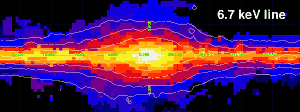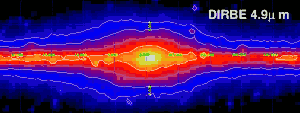|
|  |
The emission line of helium-like iron at energy about 6.7 keV is a
salient feature of a hot plasma (temperatures around 10-50 million
Kelvin). Such plasmas are present in different types of astrophysical objects,
ranging from chromospheres of normal stars through atmospheres of
accreting white dwarfs to the intracluster gas in clusters of
galaxies. However, the discovery of a 6.7-keV line in the diffuse X-ray
emission distributed along the Galactic plane (the so called
Galactic ridge X-ray emission) came as a surprise for astronomers in
the 1980-ies. The main problem is that this line indicates that the
temperature of the emitting plasma cannot be less than ten million
K. Although such hot gas can be kept bound in the deep gravitational
potential wells of compact objects, e.g. white dwarfs, or of clusters
of galaxies, the potential well of our Galaxy is not sufficiently deep
for this puprose. Therefore, should this hot plasma be distributed
through the interstellar space, it must be outflowing from the
Galactic plane. To sustain a stationary situation one needs to
constantly pump an uncomfortably huge amount of energy into the
interstellar medium.
An alternative solution is that this hot plasma does not occupy the
interstellar space but belongs to a large number of descrete X-ray
sources in the Galaxy, which are too weak to be resolved separately by X-ray
telescopes. In this case the surface brightness distribution of the
"diffuse" X-ray emission is expected to follow the distribution of the
parent sources over the Galaxy. This however could not be checked
until recently, mainly because of the relatively low surface
brightness of the ridge emission and its very large extent (more than
100 degrees along the Galatic plane and a few degrees across the
plane). Another major problem was the severe contamination of the
diffuse component by bright point X-ray sources (mainly accreting
neutron star and black holes).
Recently the team of MPA astronomers showed that the distribution
of background-like X-ray emission of the Milky Way very closely
follows the distribution of the Galactic near-infrared surface brightness
(which is a good tracer of stellar mass distribution)
in selected regions of the sky, not contaminated by bright point
sources (see
 current research March 2006).
Now it became possible to construct a much more detailed map of the Galaxy
in this background light, making use of the flux of the 6.7 keV
line. The constructed map confirms that the Galactic background X-ray
emission is distributed exactly as stars and that it originates from
superposition of X-ray emission from millions of weak Galactic X-ray
sources -- accreting white dwarfs and coronally active stars. It was
also been shown that the X-ray-near-infrared correlation is the same
throughout the Galaxy, demonstrating that the population of weak X-ray
sources is virtually uniform. current research March 2006).
Now it became possible to construct a much more detailed map of the Galaxy
in this background light, making use of the flux of the 6.7 keV
line. The constructed map confirms that the Galactic background X-ray
emission is distributed exactly as stars and that it originates from
superposition of X-ray emission from millions of weak Galactic X-ray
sources -- accreting white dwarfs and coronally active stars. It was
also been shown that the X-ray-near-infrared correlation is the same
throughout the Galaxy, demonstrating that the population of weak X-ray
sources is virtually uniform.
Revnivtsev M., Molkov S., Sazonov S.
Publication:
Revnivtsev M., Molkov S., Sazonov S.,
Map of the Galaxy in the 6.7 keV emission line, ArXiv Astrophysics
e-prints, arXiv:astro-ph/0605693 (2006)
|

